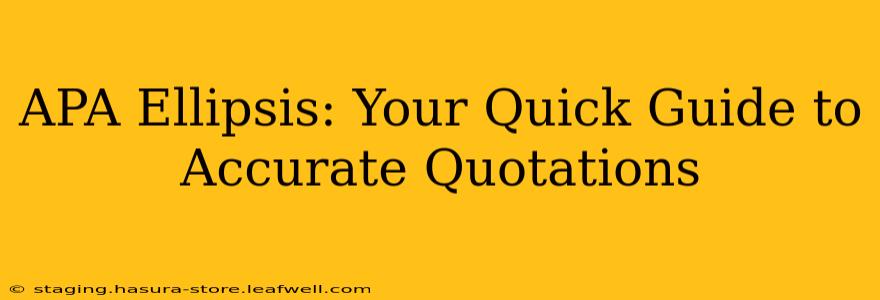Using ellipses correctly in APA style is crucial for maintaining the accuracy and integrity of your research. An ellipsis (...) indicates an omission of words from a direct quotation. Misusing them can misrepresent the original source and damage your credibility. This guide will walk you through the proper application of ellipses within APA style guidelines, ensuring your quotations are both accurate and effectively integrated into your writing.
What are Ellipses and Why Use Them in APA?
Ellipses are three dots (...) used to show that you've removed words from a direct quote. They're essential in APA style because they allow you to present only the most relevant parts of a longer quote without altering its meaning. This keeps your writing concise while still accurately representing the original source.
How to Use Ellipses in APA Style Quotations
The rules for using ellipses in APA style are fairly straightforward but require careful attention to detail:
- Use only three dots for mid-sentence omissions: If you remove words from the middle of a sentence, use three dots followed by a space. For example:
"The study showed...significant improvements in patient outcomes."
- Use four dots for omissions at the end of a sentence: If the omission occurs at the end of a sentence, use three dots followed by a period (making four dots in total), followed by a space. For example:
"The results were quite surprising....The implications require further investigation."
- Omitting entire sentences: When omitting entire sentences, simply use three dots followed by a space, and repeat as needed. You need not use four dots when omitting entire sentences. For instance:
"The experiment began at 8:00 am. ...Participants were monitored for 2 hours. The data were analyzed statistically."
- Preserving the original meaning: The most critical aspect of using ellipses is ensuring you don't distort the original meaning of the quote. Always choose omissions that maintain the integrity of the author's message. Avoid creating a false impression with your edits.
When NOT to Use Ellipses in APA
While ellipses are useful, they're not always necessary. Avoid using them:
-
When omitting only a few words: If only a few words are omitted and their removal doesn't significantly alter the meaning, it may be better to include them for clarity. Consider the flow and impact on the overall quote.
-
At the beginning of a quotation: Never use ellipses at the beginning of a direct quotation unless you're omitting material from the beginning of the original sentence.
-
To replace words you want to change: Ellipses are for omitting words; they're not a tool to manipulate a quotation's meaning. Never use them to obscure a point or change the original author's intent.
Common APA Ellipsis Questions
What if I need to omit material from the beginning and end of a quotation?
In this case, use the ellipsis at the beginning and end according to the rules described above. For example:
"...the findings suggested a strong correlation between the variables....The results support the hypothesis."
Do I need to use brackets around ellipses?
No, brackets are not typically used around ellipses in APA style. The ellipsis itself clearly indicates the omission of words. Brackets are used to clarify or add information within a quote, not to signal omissions.
What happens if the quote is already very short?
If the quotation is short enough that the ellipsis would make it too short and possibly misleading, it’s preferable to use the full quote.
Conclusion: Mastering APA Ellipses for Accurate Citations
Proper use of ellipses is a critical element of accurate and ethical academic writing. By carefully following these guidelines, you can ensure that your quotations are not only grammatically correct but also faithfully represent the original source, thus enhancing your credibility and the overall quality of your research. Remember to always prioritize the accurate representation of the original source. If you're unsure about a particular case, always err on the side of caution and include more of the original text.

